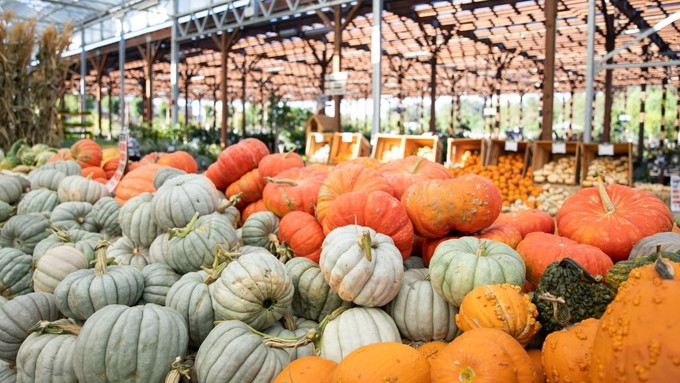
Patches now open at local nurseries; what to look for when pumpkin shopping

Just in time for Green Acres' annual Fall Festival, piles of pumpkins await shoppers at Green Acres Nursery & Supply. Photo courtesy of Green Acres Nursery & Supply www.idiggreenacres.com
It’s pumpkin time, as evidenced by brightly colored piles outside supermarkets and inside nurseries.
But how do you choose the perfect pumpkin? It depends on what you’re shopping for.
Most pumpkins now rolling into stores are for Halloween carving or decorative purposes. Most carving pumpkins – bright orange with thin rinds and smooth skin – are hybrids of Connecticut field pumpkin varieties – the classic heirloom pumpkin. It tends to weigh 15 to 20 pounds, giving these future Jack-o-lanterns some size but not too much heft.
Pumpkins with thin rinds or walls tend to be easier to carve than thick-walled varieties. How can you tell before you crack it open? Pick it up; does that pumpkin seem heavy for its size? If so, it’s thick walled. Also, look at the stem. Thick-walled pumpkins tend to have hefty, thick stems.
Thin or thick, choose a pumpkin that feels solid to the touch all the way around. Avoid any with soft spots or sunken areas; they’ve already begun to decay.
Fresh pumpkins can last several weeks if left uncarved and kept out of direct sun. But a carved pumpkin’s lifespan is mere days (if not less than 24 hours); those cut surfaces tend to mold or rot quickly.
Interest in uncarved pumpkins as fall decorations had led to a plethora of pumpkin varieties. For example, Green Acres Nursery & Supply stocks at least a dozen different varieties: Carving, Fairytale, Lumina, Lil’ Pump-Ke-Mon, Cinderella, Jarrahdale, Big Max, Cronus, Iron Man, Knucklehead, One Too Many and Lunch Lady plus mini pumpkins, winged gourds and gooseneck gourds.
Need carving and decorating ideas – or want to show off your own skill? As part of its Fall Festival on Saturday, Sept. 30, Green Acres is hosting a pumpkin decorating contest at each of its seven locations. Decorate and/or carve the pumpkin in advance and enter it before 9:30 a.m. at the store’s contest table. Categories include Scariest, Silliest and Most Creative. Winners will be announced Monday, Oct. 2.
Green Acres’ Fall Festival also includes pumpkin-inspired games, crafts and workshops including how to turn a pumpkin into a succulents planter. Festival hours are 9 a.m. to 4 p.m. Saturday; admission and parking are free.
Green Acres is located in Sacramento, Auburn, Citrus Heights, Elk Grove, Folsom, Rocklin and Roseville. For addresses, directions and more details on the Fall Festival: https://idiggreenacres.com/.
Comments
0 comments have been posted.Sacramento Digs Gardening to your inbox.
Food in My Back Yard Series
May 6: Maintain soil moisture with mulch for garden success
April 29: What's (already) wrong with my tomato plants?
April 22: Should you stock up on fertilizer? (Yes!)
April 15: Grow culinary herbs in containers
April 8: When to plant summer vegetables
April 1: Don't be fooled by these garden myths
March 25: Fertilizer tips: How to 'feed' your vegetables for healthy growth
March 18: Time to give vegetable seedlings some more space
March 11: Ways to win the fight against weeds
March 4: Potatoes from the garden
Feb. 25: Plant a fruit tree now -- for later
Feb. 18: How to squeeze more food into less space
Feb. 11: When to plant? Consider staggering your transplants
Feb. 4: Starting in seed starting
Sites We Like
Garden Checklist for week of May 4
Enjoy this spring weather – and get gardening!
* Plant, plant, plant! It’s prime planting season in the Sacramento area. Time to set out those tomato transplants along with peppers and eggplants. Pinch off any flowers on new transplants to make them concentrate on establishing roots instead of setting premature fruit.
* Direct-seed melons, cucumbers, summer squash, corn, radishes, pumpkins and annual herbs such as basil.
* Harvest cabbage, lettuce, peas and green onions.
* In the flower garden, direct-seed sunflowers, cosmos, salvia, zinnias, marigolds, celosia and asters. (You also can transplant seedlings for many of the same flowers.)
* Plant dahlia tubers. Other perennials to set out include verbena, coreopsis, coneflower and astilbe.
* Transplant petunias, marigolds and perennial flowers such as astilbe, columbine, coneflowers, coreopsis, dahlias, rudbeckia and verbena.
* Keep an eye out for slugs, snails, earwigs and aphids that want to dine on tender new growth.
* Feed summer bloomers with a balanced fertilizer.
* For continued bloom, cut off spent flowers on roses as well as other flowering plants.
* Add mulch to the garden to maintain moisture. Mulch also cuts down on weeds. But don’t let it mound around the stems or trunks of trees or shrubs. Leave about a 6-inch to 1-foot circle to avoid crown rot or other problems.